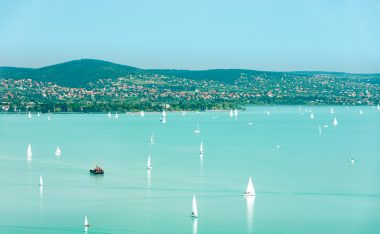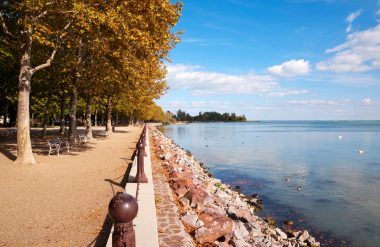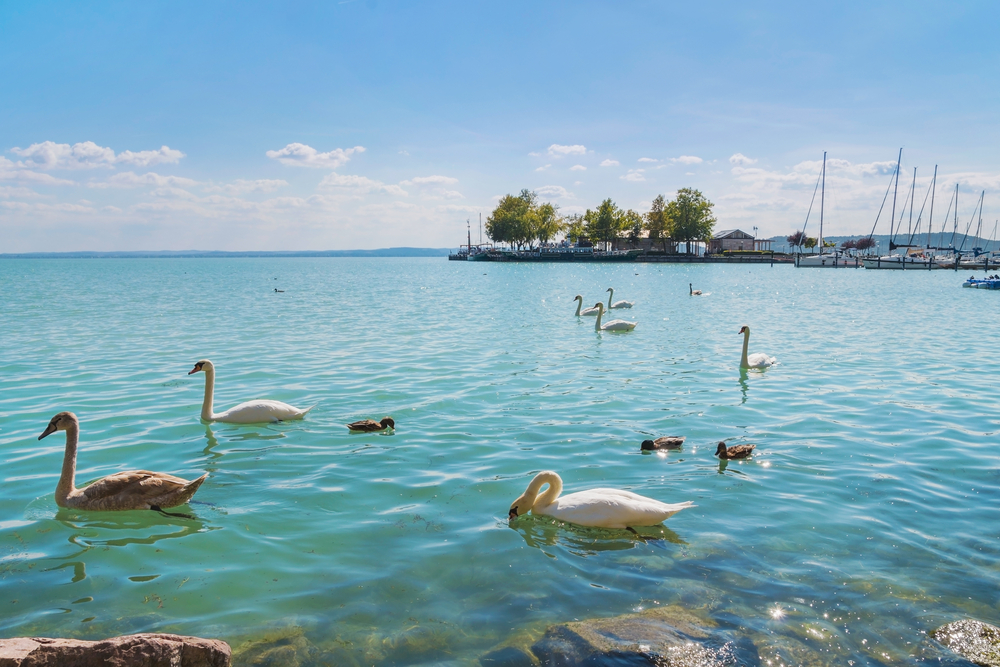On the northern shore of Lake Balaton (Balaton) in western Hungary lies the pretty town of Balatonfüred. In English translation, Balatonfüred means Bad Balaton. The spa town has around 13,000 inhabitants and is located in the centre of the Balaton Riviera.
The region of Balatonfüred was settled as early as Roman times. The first documented mention took place in 1211, when the Tihany Abbey owned the land. The carbonated thermal springs of the village have been known since 1717. The mild climate also ensured that more and more visitors traveled to Bad Balaton over time.
Geographically, Balatonfüred is located at an altitude of 117 meters above sea level.
Balatonfüred – Popular holiday resort

In the 19th century, Balatonfüred became a lively and popular health resort. The thermal healing springs are considered helpful for the treatment of heart and circulatory diseases. Bathing and drinking cures are carried out. Through the influence of the Hungarian magnate and large landowner Emanuel Graf Zichy-Ferraris (1808-1877), Balatonfüred developed into a bathing and cultural resort on Lake Balaton. The focus of the efforts was on bathing life. In 1861, a theatre in Bad Balaton was also able to start operations. In addition, the spa town has been continuously beautified.
In In the 19th century, Bad Balaton experienced its heyday. Many politicians and artists frequented it. A monument was even erected to the actress Lujza Blaha (1850-1926). In In the 20th century, the Indian artist, philosopher and Nobel Prize winner Rabindranath Tagore (1861-1941) was a prominent guest.
Today, an average of around 50,000 guests visit Balatonfüred every year, which has modern facilities and several hotels and restaurants. Even today, Bad Balaton has managed to retain its charm and present itself magnificently. Balatonfüred, for example, includes some imposing manor houses and villas. In the city park, which is located between the spa square and the harbour, numerous rare plants thrive.
Due to its special location, combined with the healing effects of the thermal springs and the famous Hungarian hospitality, the spa is an ideal holiday destination in all seasons.
How to get to Balatonfüred
Balatonfüred can be easily reached by plane via Balaton Fly Airport or from Budapest Airport. There are also regular trains from the Hungarian capital in the direction of Balatonfüred.
But the spa town can also be easily reached by car from Budapest. First, take the M7 motorway to Székesfehérvár/Balaton. From there, turn off at exit 90 in the direction of Bundesstraße 71. In the direction of Balatonfuzfo and Balatonmadi, it goes to Balatonfüred. However, the car route stretches over a length of 129 kilometers. In some cases, fees must also be paid for the use of the roads.
From southern Austria, Balatonfüred can be reached by car via the E66 and the main road 73. Within Balatonfüred there are Balaton taxis and buses.
The sights of Balatonfüred

The sights of the spa town include numerous historical buildings, some of which date back to the 17. and 18th century. The townscape is dominated by the Széchenyi Ferenc Castle, the Pálóczi Horváth Ádám House and the Fountain House, which is located at the Kossuth Lajos Spring. In particular, the Horváth House is one of the most famous buildings in the city. In 1825, for example, the famous Anna Ball took place there for the first time. The building at the Kossuth Lajos water source was built around 1800. It was rebuilt in 1853.
There are also several sacral buildings in Balatonfüred. These include the Reformed Church, the Roman Catholic parish church, the Protestant church, the Adventist house of prayer and the synagogue of the Jewish community.
The monuments of Balatonfüred are also worth seeing, such as the summer residence of the Hungarian actress Lujsa Blaha called Blaha Lujza Nyraloja. She was considered the nightingale of the nation and often spent her summer holidays in Bad Balaton between 1893 and 1916. The residence was built in 1867 and is now a hotel.
Another monument is the Huray villak house, which was once owned by the physician Huray István and was built around 1860. At present, it is used by the local tourism committee.
Built in 1730, Nagyvendéglö catered to numerous bathers. In modern times, it is part of the Anna Grand Hotel.
The museums are also worth a visit. Since 1954, the apartment of the Hungarian writer and journalist Mór Jókai (1825-1904), who belonged to the Hungarian Academy of Sciences, has served as the Jókai emlékmúzeum as an exhibition venue that provides information about the author’s way of life. From 1870 he lived in Balatonfüred for a long time.
Other museums in the city are the Laczkó Deszo Múzeum, with its art-historical exhibitions and documents from the last 200 years, and the Heltörténeti Gyüjtémeny, which presents local history collections.
Activities
Friends of water sports will get their money’s worth at Lake Balaton. There are a variety of water sports opportunities there. Furthermore, it is excellent to hike or cycle around the city. A well-known dance event in the city is the Anna Ball, which has been around since 1825. Interested parties have the opportunity to participate.
Children are in good hands in the covered wellness and aqua park Annagora. The park offers eight different slides and wave pools. There is also a special wellness department.
In addition, visitors will find many shopping opportunities in Balatonfüred. Nightlife enthusiasts can visit the various discos, clubs or pubs.
Accommodations in Balatonfüred
In addition to various hotels, there are also numerous guesthouses, holiday homes and apartments available for guests in Balatonfüred. There is also a campsite.


